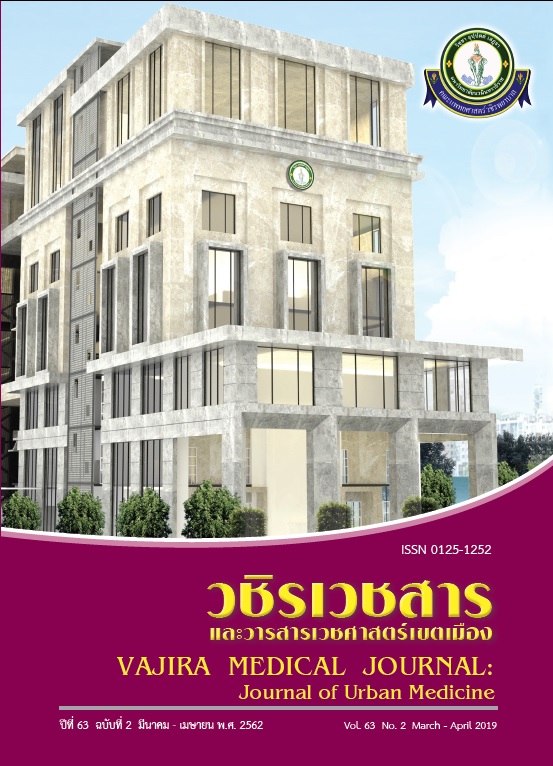Prevalence of potential drug-drug interactions in HIV-infected adults taking antiretroviral drugs at Vajira Hospital
Main Article Content
Abstract
Background: Patients with HIV who are receiving antiretroviral (ARV) therapy are at risk for drug interactions. Potential drug-drug interactions (PDDIs) are frequent. Data regarding potential drug-drug interactions in HIV-positive individuals in Thailand are limited.
Objectives: To investigate the prevalence and risk factors of PDDIs between ARVs and co-administered drugs. Material and Method: A retrospective study of HIV patients treated at the infectious clinic of Vajira Hospital was performed from April 2014 to June 2014. PDDIs were screened by using the Liverpool drug interactions database, defined as red flag interaction (contraindicated, avoid, or not recommended), and orange flag interaction (caution, close monitoring, or capable of causing clinical deterioration).
Results: Of 1,320 patients, 711 (53.86%) were male and the mean age was 44 ± 9 years. Median CD4 count was 495 cells/mm3 (11-1,657). Fourteen (1.06%) had tuberculosis coinfection. Overall 82.05% and 20.38% of patients received Non-nucleoside reverse-transcriptase inhibitors (NNRTI) and protease inhibitor (PI)-based regimens, respectively. Nevirapine is the most commonly used NNRTI (49.09%) while Lopinavir/ritonavir (LPV/r) is the most commonly used in PI (74.63%). A total of 533 patients out of 1,320 HIV patients (40.38%) were at risk for a PDDI. Red flag interactions were 1.81% (12/664 events) and orange flag interactions were 98.19% (652/664 events). Major interactions most frequently involved rifampicin in red flag interactions and statins in orange flag interactions. In the multivariate analysis, factors associated with having PDDIs were male gender (OR 1.30, 95% CI 1.01-1.68), advanced age (age ≥ 50 years) (OR 2.20, 95% CI 1.63-2.95), 2 co-medications (OR 13.56, 95% CI 8.53-21.55), ≥ 3 co-medications (OR 41.07, 95% CI 12.68-133.06), and tuberculosis coinfection (OR 44.02, 95% CI 2.62-739.47) respectively.
Conclusions: The prevalence of PDDIs is high among HIV-infected adults on ARV drugs at Vajira Hospital. The risk for PDDIs increased significantly in males, aged ≥ 50 years, with polypharmacy, and coinfection with tuberculosis.
Downloads
Article Details
References
2. Marzolini C, Elzi L, Gibbons S, Weber R, Fux C, Furrer H, et al. Prevalence of comedications and effect of potential drug-drug interactions in the Swiss HIV Cohort Study. Antivir Ther. 2010 15(3):413–23.
3. Kigen G, Kimaiyo S, Nyandiko W, Faragher B, Sang E, Jakait B, et al. Prevalence of Potential Drug-Drug Interactions Involving Antiretroviral Drugs in a Large Kenyan Cohort. PLoS One. 2011; 6(2): e16800. doi: 10.1371/journal.pone.0016800
4. OFFERING INFORMATION ON HIV/AIDS TREATMENT, PREVENTION, AND RESEARCH. Guidelines for the Use of Antiretroviral Agents in HIV-1-Infected Adults and Adolescents [Internet]. Rockville, MD: Department of Health and Human Services USA; 2014 [cited 2014 May 1] Available from: https://aidsinfo.nih.gov/contentfiles/adultandadolescentgl003093.pdf
5. Liverpool HIV drug interactions [Internet]. LIVERPOOL(U.K.); [cited 2015 Feb 10] Available from: https://www.hiv-druginteractions.org
6. Evans-Jones JG, Cottle LE, Back DJ, et al. Recognition of risk for clinically significant drug interactions among HIV-infected patients receiving antiretroviral therapy. Clin Infect Dis. 2010;50:1419-1421. doi:10.1086/652149.
7. Centers for Disease Control and Prevention Office of Infectious Diseases National Center for HIV/AIDS, Viral Hepatitis, STD, and TB Prevention. Managing Drug Interactions in the Treatment of HIV-Related Tuberculosis [Internet]. USA: Centers for Disease Control and Prevention;2013. Available from: https://www.cdc.gov/tb/publications/guidelines/tb_hiv_drugs/pdf/tbhiv.pdf
8. Dooley KE, Flexner C, Andrade AS. Drug interactions involving combination antiretroviral therapy and other anti-infective agents: repercussions for resource-limited countries. J Infect Dis 2008; 198:948–61.
9. Foy M, Sperati CJ, Lucas GM, Estrella MM. Drug interactions and antiretroviral drug monitoring. Curr HIV/AIDS Rep. 2014;11(3):212-22.
10. Winston A, Underwood J. Emerging concepts on the use of antiretroviral therapy in older adults living with HIV infection. Curr Opin Infect Dis. 2015;28:17-22.
11. Nachega JB, Hsu AJ, Uthman OA, Spinewine A, Pham PA. Antiretroviral therapy adherence and drug–drug interactions in the aging HIV population. AIDS. 2012;26 Suppl 1:S39–S53.
12. Chauvin B, Drouot S, Barrail-Tran A, Taburet AM. Drug-drug interactions between HMG-CoA reductase inhibitors (statins) and antiviral protease inhibitors. Clin Pharmacokinet. 2013;52(10):815-31. doi: 10.1007/s40262-013-0075-4.
13. Holtzman C, Armon C, Tedaldi E, Chmiel JS, Buchacz K, Wood K, et al. Polypharmacy and risk of antiretroviral drug interactions among the aging HIV infected population. J Gen Intern Med. 2013;28(10):1302-10.
14. Tseng A, Szadkowski L, Walmsley S, Salit I, Raboud J. Association of age with polypharmacy and risk of drug interactions with antiretroviral medications in HIV-positive patients. Ann Pharmacother. 2013;47(11):1429-39.
15. Gleason LJ, Luque AE, Shah K. Polypharmacy in the HIV-infected older adult population. Clin Interv Aging. 2013;8:749-63.
16. Seden K, Khoo SH, Back D, Byakika-Kibwika P, Lamorde M, Ryan M, ed al. Global patient safety and antiretroviral drug-drug interactions in the resource-limited setting. J Antimicrob Chemother. 2013 Jan;68:1-3.
17. Edelman EJ, Gordon KS, Glover J, McNicholl IR, Fiellin DA, Justice AC. The next therapeutic challenge in HIV: polypharmacy. Drugs Aging. 2013;30(8):613-28.


